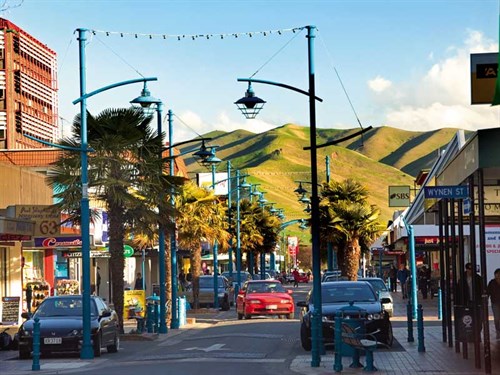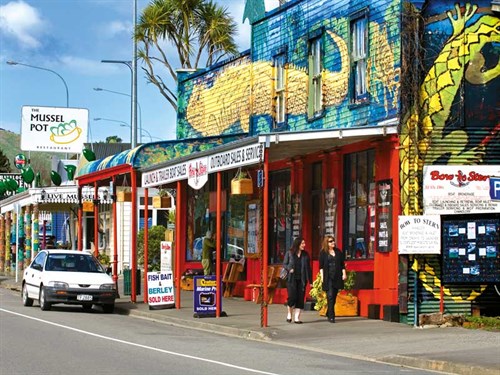
Blenheim is located on the Wairau plain, a welcome stretch of flat land after the twists and turns of the dark, bush clad hills around Picton. It’s surrounded by squares of gold and green pasture interspersed with sections of pinstriped rows of grapevines.
The effect, when seen from afar, is like a giant chessboard. And in autumn the colours were especially impressive – many of the vineyards were pruning back as the vines’ leaves faded into dusty reds and oranges. Some had already lost their foliage and stood with their vines contorted into odd shapes. On either side of the plain are mountains smudged a smoky blue by their distance. Blenheim looked magnificent. I knew I would enjoy it.
I stayed at the Blenheim Top 10 Holiday Park on Grove Road, one of the first turn-offs after you enter Blenheim from the north. The map supplied at the office directed me to a powered spot on a grassy knoll almost equal distance between the ablutions/kitchen block and the fish and chip shop. Perfect.
As tourists, and their RVs, are no strangers to the Marlborough region, Blenheim’s town centre and surrounding streets provide plenty of spaces for day-time parking – paid for the former and free if you don’t mind parking further out and walking.
The town centre caters for a large number of visitors each year, and has just about anything anyone could ever need. Forget about a small town with a dairy and a petrol station – there are plenty of trendy cafes, upmarket restaurants, and retail shops here. The footpaths are wide and paved a cheery terracotta colour, and bright blue bollards and lampposts add to the summer-holiday atmosphere of the place.
I took a break at Riverside Park, which is bordered by cafes and benches at the edge of the main shopping area. Built up around the Taylor River, the park’s wooden boardwalks, water feature, gardens, and ducks make it a pleasant place to people-watch. The majority of the folk here were taking advantage of the cool, clear weather and striding along the River Walk that runs through the town. It is just one of the many walks that have been developed in and around Blenheim. The area’s flat geography and well-maintained, wide concrete pathways make it easy to get some exercise.
As it was on the edge of winter (my favourite time of the year), many of the trees were still dressed in autumnal yellow, crimson, and rust. They made the park even more colourful than I imagine it would be in summer.
Another peaceful pocket close to the centre Blenheim is the War Memorial and Clock Tower in Seymour Square.

Constructed from slate grey, stark white, and pale bluish stone, which seemed to gleam in the clear, wintry sun, the memorial is a dignified and decorous monument to lives lost in past battles. The clock at its top chimes every quarter hour.
There are trees and gardens dotted around the park, as well as a fountain at its centre. It was carpeted in burgundy and rust-coloured leaves moving in wild swirls and flurries. For those wanting culture, the Millennium Art Gallery can be found just behind Seymour Square.
I might not know a lot about vineyards and wine, but one thing I didn’t want to miss was the Omaka Aviation Heritage Centre on Aerodrome Road, about five kilometres from Blenheim itself. The centre has a large collection of rare aircraft from World War One – some are even in flyable condition – and aviation memorabilia.
But what I really wanted to see were the dioramas reflecting scenes from World War One. Weka Workshop, well known for its association with the Lord of the Rings trilogy, created what the centre calls “dramatic aviation theatre” and that is the perfect description for the amazingly detailed scenes.
In one corner, the body of the Red Baron lies beside his downed Fokker Triplane, while Australian troops scrounge for souvenirs from the crash. In another sits a replica French Nieuport 24, with a partly-constructed Bristol Fighter frozen in time across the room. Being able to look at these life-size (and, in some cases, original) structures of canvas, wood, and cables in such emotive setups makes the experience so much more poignant. They come from an era when flying was so dangerous pilots weren’t expected to last more than a few weeks.
I managed to fit a lot into a weekend because there is a lot to see in Blenheim. It might not have been wine-tasting season, or summer, but I was certainly impressed during my fleeting autumn visit.
Places to eat and drink in Blenheim
Riverside Park in Blenheim is bordered by cafes and seating at the edge of the main shopping area.
Wine and vineyard tours: Marlborough is New Zealand’s largest wine growing area with 150 wineries, 550 grape growers and 40 cellar doors in the region, most of them in the Wairau and Awatere Valleys.
The Mussel Pot: this singular little restaurant in Havelock has been serving up locally-harvested green-lipped mussels for the last twenty years. You can enjoy them smoked, battered grilled, or in chowder or salads.
Dodson Street Beer Garden: this real-ale house and beer garden serves a large range of award-winning craft beer and cider as well as pizzas and German cuisine.






